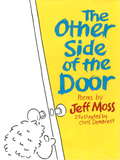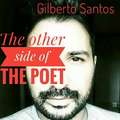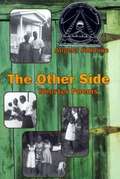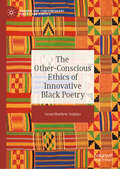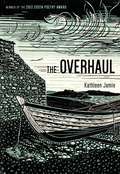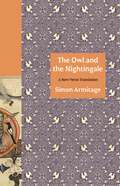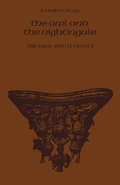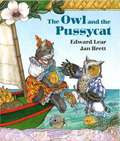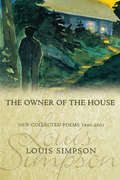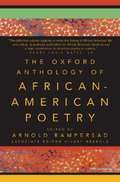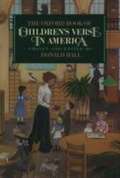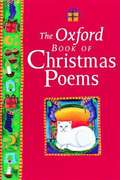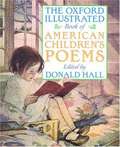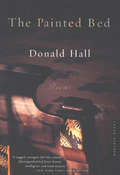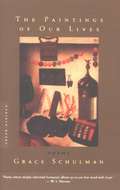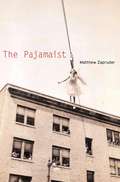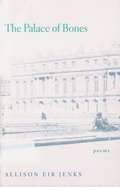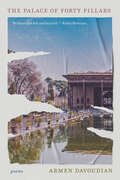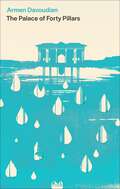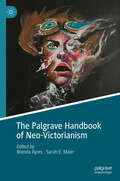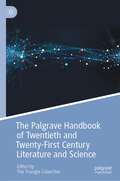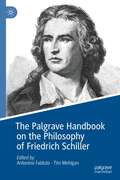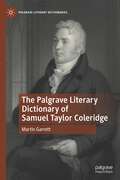- Table View
- List View
The Other Side of the Door
by Jeff MossA wise and whimsical collection of poems by Jeff Moss about a variety of subjects both real and imaginary.NOTE: This version does not include illustrations.
The Other Side of the Poet
by J. Félix H. F. Gilberto SantosWho has never allowed themselves to think good and bad, be beautiful and ugly, even if everything costs a price, this book comes to show that we have both sides, even when we don’t want to, the thoughts of the other side of the poet, an anthology of life, the life in the book.
The Other Side: Shorter Poems
by Angela JohnsonSeries of poems about the author's memories of Shorter, Alabama, a small Southern town that was torn down after the author had grown and moved away. But her memories of the town linger. The poems are poignant, vivid snapshots of a Southern, simple, rural, hard, and hard-loving way of life with topics from race relations to remembering Grandmama.
The Other-Conscious Ethics of Innovative Black Poetry (Modern and Contemporary Poetry and Poetics)
by Grant Matthew JenkinsThis monograph identifies and investigates the ‘other-conscious’ ethics in black avant-garde poetry since the 1980s. Drawing on a long tradition in the African Diaspora of ethical writings that put the Other first, this work shows how black poets writing in an avant garde or experimental vein in the United States push language to its limits to reveal how poetry can address and exemplify ethical postures towards other people. This other-centered vantage allows the poets to incisively comment on some of this period’s most pressing ethical issues, including postcolonial and racialized violence, the history of slavery and segregation in America, and the expansion of human consciousness. The writers involved in this study include Nathaniel Mackey, Erica Hunt, Will Alexander, Harryette Mullen, and Mark McMorris.
The Overhaul: Poems
by Kathleen JamieWinner of the 2012 Costa Poetry Award, the latest collection by Kathleen Jamie, "the leading Scottish poet of her generation" (The Sunday Times)See when it all unravels—the entire projectreduced to threads of moss fleeing a nor'wester;d'you ever imagine chasing just one strand, letting it lead youto an unsung cleft in a rock, a place you could take to,dig yourself in—but what are the chances of that? Of the birds,few remain all winter; half a dozen wadersmediate between sea and shore, that space confirmed—don't laugh—by your own work. —from "Materials"The Overhaul continues Kathleen Jamie's lyric inquiry into the aspects of the world our rushing lives elide, and even threaten. Whether she is addressing birds or rivers, or the need to accept loss, or, sometimes, the desire to escape our own lives, her poetry is earthy and rigorous, her language at once elemental and tender. The Overhaul is a midlife book of repair, restitution, and ultimately hope—of the wisest and most worldly kind.
The Ovidian Vogue
by Daniel D. MossThe Roman poet Ovid was one of the most-imitated classical writers of the Elizabethan age and a touchstone for generations of English writers. In The Ovidian Vogue, Daniel Moss argues that poets appropriated Ovid not just to connect with the ancient past but also to communicate and compete within late Elizabethan literary culture.Moss explains how in the 1590s rising stars like Thomas Nashe and William Shakespeare adopted Ovidian language to introduce themselves to patrons and rivals, while established figures like Edmund Spenser and Michael Drayton alluded to Ovid's works as a way to map their own poetic development. Even poets such as George Chapman, John Donne, and Ben Jonson, whose early work pointedly abandoned Ovid as cliché, could not escape his influence. Moss's research exposes the literary impulses at work in the flourishing of poetry that grappled with Ovid's cultural authority.
The Owl and the Nightingale: A New Verse Translation (The Lockert Library of Poetry in Translation #134)
by Simon ArmitageFrom the UK Poet Laureate and bestselling translator of Sir Gawain and the Green Knight, a complete verse translation of a spirited and humorous medieval English poemThe Owl and the Nightingale, one of the earliest literary works in Middle English, is a lively, anonymous comic poem about two birds who embark on a war of words in a wood, with a nearby poet reporting their argument in rhyming couplets, line by line and blow by blow. In this engaging and energetic verse translation, Simon Armitage captures the verve and humor of this dramatic tale with all the cut and thrust of the original.In an agile iambic tetrameter that skillfully amplifies the prosody and rhythm of the original, Armitage’s translation moves entertainingly from the eloquent and philosophical to the ribald and ridiculous. Sounding at times like antagonists in a Twitter feud, the owl and the nightingale quarrel about a host of subjects that still resonate today—including love, marriage, identity, cultural background, class distinctions, and the right to be heard. Adding to the playful, raucous mood of the barb-trading birds is Armitage, who at one point inserts himself into the poem as a “magistrate . . . to adjudicate”—one who is “skilled with words & worldly wise / & frowns on every form of vice.”Featuring the Middle English text on facing pages and an introduction by Armitage, this volume will delight readers of all ages.
The Owl and the Nightingale: The Poems and Its Critics
by Kathryn HumeThe Owl and the Nightingale is clearly one of the few major Middle English poems. Despite the clarity and simplicity of its text, however, the poem has occasioned bitter and still unresolved interpretative controversy. Is the key to its meaning to be found in bird lore? the debate form? Is the poem a political or religious allegory? Despite the radical contradictions in the conclusions of previous critics, most of them have implicitly claimed a unique and exclusive validity. Kathryn Hume's purpose in writing this book is to offer a new account of the poem, one based on a systematic attempt to assess the validity and usefulness of various possible approaches to the work. She shows saneness, balance, and humour both in her criticism of previous interpretations and in her own conclusions. We need, she insists, to understand the nature of the poem before we erect elaborate theories about its meaning. The contradictoriness of the relevant avian traditions, the birds' complete incompetence as debaters, the poem's curiously indeterminate ending, and the critics' inability to agree even on the subject of the controversy, she argues, makes it difficult to see the work as a serious debate about anything. Attempts to find an extrinsic or allegorical meaning have proven radically contradictory and have all neglected large portions of the poem. But since no serious issue is present in the bird's dialogue, the meaning of the poem must indeed be sought elsewhere. Analysis of The Owl and the Nightingale's sequential impact and its manipulation of audience response emphasize the debate's lack of direction, its bitterness, and also – from the reader's point of view – its humour. Kathryn Hume argues that a great deal is clarified and made comprehensible if we regard the poem as a burlesque-satire on human contentiousness. The birds' illogic, the wandering arguments, the unsystematic introduction of various human concerns, and the inconclusive ending are all consistent with the idea that the poem was written as a witty caricature of petty but vicious human quarrelling. Both for its sane reinterpretation of what is widely considered one of the masterpieces of Middle English literature and for the interpretative methodology it employs, The Owl and the Nightingle: The Poem and Its Critics should be of lasting value to medievalists.
The Owl and the Pussycat
by Edward LearRealistic portrayals of sea creatures abound, and honeybees with exactingly delineated wings swoop above a fanciful beehive. Waves swell and swirl around the pea-green boat, the owl holds his guitar with large outstretched feathers and looks appropriately lovelorn.
The Owner of the House: New Collected Poems 1940-2001 (American Poets Continuum)
by Louis SimpsonFew poets have so artfully confronted American life as Louis Simpson. Persona speakers struggle with everyday issues against a backdrop of larger forces, the individual&’s maladjustment to a culture of materialism and brutal competition, the failure of marriage under the pressures of such a society, the failure of the American dream. Simpson wages a lover&’s quarrel with the world."Louis Simpson has perfect pitch. His poems win us first by their drama, their ways of voicing our ways . . . of making do with our lives. Then his intelligence cajoles us to the brink of a cliff of solitude and we step over into the buoyant element of true poetry."—Seamus HeaneyEducated at Munro College (West Indies) and at Columbia University, Louis Simpson has taught widely, most recently at the State University of New York at Stony Brook. He is the author of seventeen books of poetry and ten works of prose. He has received fellowships from the Academy of American Poetry, the Hudson Review, the Guggenheim Foundation, and received the Pulitzer Prize for Poetry.
The Oxford Anthology of African-American Poetry
by Arnold Rampersad Hilary HerboldFor over two centuries, black poets have created verse that reflects the sorrows, joys, and triumphs of the African-American experience. Reflecting their variety of visions and styles, The Oxford Anthology of African-American Poetry aims to offer nothing less than a definitive literary portrait of a people.
The Oxford Book of Children's Verse in America
by Donald HallIn the tradition of Iona and Peter Opie's Oxford Book of Children's Verse comes this anthology by the award-winning poet and children's book author Donald Hall. Bringing together "poems written for children and also poems written for anybody which children have enjoyed," the book includes anonymous works, ballads, and recitation pieces, beginning with the Calvinist verses of the seventeenth century. Hall has collected poems from Sunday School magazines, Christmas annuals for children, and children's periodicals such as St. Nicholas and Youth's Companion. Many marvelous writers, some no longer remembered, wrote almost every month for these nineteenth and twentieth century publications. In addition to the expected names of Longfellow and Whittier, we find Sarah Josepha Hale ("Mary Had a Little Lamb"), Mary Mapes Dodge (creator of Hans Brinker), and Palmer Cox (with his marvelous Brownies). Twentieth century authors abound: Ogden Nash, T.S. Eliot, John Updike, Theodore Roethke, to name just a few. The book concludes with the fabulous nonsense of present-day writers like Shel Silverstein and Nancy Willard.
The Oxford Book of Christmas Poems
by Michael Harrison Christopher Stuart-ClarkThis book contains well over 100 Christmas poems--old and new, traditional and modern--and features four sections, starting in winter, moving through Advent, and exploring the Nativity and the heart of the Christmas season and ending with the arrival of spring. It is the perfect anthology for Christmas, The Oxford Book of Christmas Poems contains a wide range of poems, old and new, well loved and less familiar. A whole host of poets are here including Ted Hughes, John Betjeman, T. S. Eliot, Walter de la Mare, Charles Causley, Dylan Thomas, W. H. Auden and Roger McGough -- along with traditional verses and carols. The Index is included. Adaptations have been made to preserve the format for Braille, auditory and print readers. Page Numbers reflect the book content and hard page breaks. A few pages were presented on two pages because of their great length labeled, for example, 157 Part A and 157 Part B. Contains British spelling and many uniquely spelled words and punctuation devised by the authors to fit their poetry. Also contains antiquated language. The poems, contents Index have been proofread word by word and spell checked. Expect unusual words like: snowful, Haie-aie, Sem, wot, and smit, yeeres, boyes and tending. The Bookshare collection also contains The Oxford Book of Christmas Stories.
The Oxford Book of Poetry for Children
by Edward BlishenA compilation of many famous children's poems.
The Oxford Illustrated Book of American Children's Poems
by Donald HallAn anthology of American poems, arranged chronologically, from colonial alphabet rhymes to Native American cradle songs to contemporary poems.
The Painted Bed: Poems
by Donald HallThe former US poet laureate delivers a book “filled with raw sexual disclosures, rowdy anger and a self-blasting mockery” (The New York Times).Donald Hall’s fourteenth collection opens with an epigraph from the Urdu poet Faiz: “The true subject of poetry is the loss of the beloved.” In that poetic tradition, as in The Painted Bed, the beloved might be a person or something else—life itself, or the disappearing countryside. Hall’s new poems further the themes of love, death, and mourning so powerfully introduced in his Without (1998), but from the distance of passed time. A long poem, “Daylilies on the Hill 1975-1989,” moves back to the happy repossession of the poet’s old family house and its history—a structure that “persisted against assaults” as its generations of residents could not. These poems are by turns furious and resigned, spirited and despairing—”mania is melancholy reversed,” as Hall writes in another long poem, “Kill the Day.” In this book’s fourth and final section, “Ardor,” the poet moves toward acceptance of new life in old age; eros reemerges.“More controlled, more varied and more powerful, this taut follow-up volume [to Without] reexamines Hall’s grief while exploring the life he has made since. The book’s first poem, ‘Kill the Day,’ stands among the best Hall has ever written.” —Publishers Weekly“A compelling, sometimes shocking, and certainly deeply moving depiction of bereavement.” —Poetry“Hall has continued growing as a poet, and his steady readers may consider this his finest collection . . . Bleakness and beauty characterize the reminiscent lyrics that follow, too, joined by a breathtaking bluntness.” —Booklist
The Paintings of Our Lives
by Grace SchulmanGrace Schulman's fourth collection of poetry, THE PAINTINGS OF OUR LIVES, celebrates earthly things while discovering inner lives. Here are poems of love and marriage -- including a psalm for the poet's anniversary and a portrayal of her parents dancing during the Depression -- and poems identifying with the hungers, sorrows, and joys of Chaim Soutine, Margaret Fuller, Paul Celan, and Henry James. In the final sonnet sequence, Schulman confronts her mother's death, calling on the art of many cultures to illuminate the universality of grief.
The Pajamaist
by Matthew Zapruder"Zapruder's hip lyricism offers both the slippery comedy and a surprisingly grave, ultimately winning, commitment to real people, emotions, locales."--Publishers WeeklyMatthew Zapruder is a young poet reinvigorating American letters. In his second collection he engages love, mortality, and life in New York City after 9/11. The title piece, a prose-poem synopsis of an unwritten novel, turns all literary forms upon themselves with savvy and flair, while the elegy cycle "Twenty Poems for Noelle" is a compassionate song for a suffering friend.Noelle, somewhere in an apartmentsymphony number twolistens to you breathing.Broken glass in the street.What was once unglowing glows . . .The Pajamaist is an intimate book filled with sly wit and an ever-present, infectious openness to amazement. Zapruder's poems are urbane and constantly, curiously searching.
The Palace of Bones: Poems
by Allison Eir JenksThis collection includes: Forgive Us, Waiting, The Prisoner, The Boy of Sea, After the Parade, In Search of a Brother...
The Palace of Forty Pillars
by Armen DavoudianA San Francisco Chronicle and LitHub Best Book of Spring A Most Anticipated Book of the Season at The Rumpus, Publishers Weekly, and Autostraddle “Brilliant and deft and heartfelt."—Richie Hofmann Wry, tender, and formally innovative, Armen Davoudian’s debut poetry collection, The Palace of Forty Pillars, tells the story of a self estranged from the world around him as a gay adolescent, an Armenian in Iran, and an immigrant in America. It is a story darkened by the long shadow of global tragedies—the Armenian genocide, war in the Middle East, the specter of homophobia. With masterful attention to rhyme and meter, these poems also carefully witness the most intimate encounters: the awkward distance between mother and son getting ready in the morning, the delicate balance of power between lovers, a tense exchange with the morality police in Iran. In Isfahan, Iran, the eponymous palace has only twenty pillars—but, reflected in its courtyard pool, they become forty. This is the gamble of Davoudian’s magical, ruminative poems: to recreate, in art’s reflection, a home for the speaker, who is unable to return to it in life.
The Palace of Forty Pillars
by Armen Davoudian'In this formally radical debut, Armen Davoudian shows how rhyme enacts longing for a homeland left behind; how meter sings to a lost beloved; and how a combination of the two can map a self - or idea of the self - relinquished so that a new life, and all the happiness it deserves, can take shape' Paul Tran'Marks the arrival of a notable new voice . . . The Palace of Forty Pillars is a moving book as well as an elegant one; its central preoccupation with the theme of belonging speaks memorably to one of the most urgent questions of our time' Andrew MotionWry, tender, and formally innovative, Armen Davoudian's debut poetry collection, The Palace of Forty Pillars, tells the story of a self estranged from the world around him as a gay adolescent, an Armenian in Iran, and an immigrant in America. It is a story darkened by the long shadow of global tragedies - the Armenian genocide, war in the Middle East, the specter of homophobia. With masterful attention to rhyme and meter, these poems also carefully witness the most intimate encounters: the awkward distance between mother and son getting ready in the morning, the delicate balance of power between lovers, a tense exchange with the morality police in Iran.In Isfahan, Iran, the eponymous palace has only twenty pillars - but, reflected in its courtyard pool, they become forty. This is the gamble of Davoudian's magical, ruminative poems: to recreate, in art's reflection, a home for the speaker, who is unable to return to it in life.
The Palgrave Handbook of Neo-Victorianism
by Brenda Ayres Sarah E. MaierThis handbook offers analysis of diverse genres and media of neo-Victorianism, including film and television adaptations of Victorian texts, authors’ life stories, graphic novels, and contemporary fiction set in the nineteenth century. Contextualized by Sarah E Maier and Brenda Ayres in a comprehensive introduction, the collection describes current trends in neo-Victorian scholarship of novels, film, theatre, crime, empire/postcolonialism, Gothic, materiality, religion and science, amongst others. A variety of scholars from around the world contribute to this volume by applying an assortment of theoretical approaches and interdisciplinary focus in their critique of a wide range of narratives—from early neo-Victorian texts such as A. S. Byatt’s Possession (1963) and Jean Rhys’ Wide Sargasso Sea (1966) to recent steampunk, from musical theatre to slumming, and from The Alienist to queerness—in their investigation of how this fiction reconstructs the past, informed by and reinforming the present.
The Palgrave Handbook of Twentieth and Twenty-First Century Literature and Science (Palgrave Handbooks of Literature and Science)
by Rebecca Walsh Priscilla Wald Gerry Canavan Monique Allewaert Nicholas Gaskill Patrick Jagoda Neel Ahuja Rebecca Evans Aarthi Vadde Britt Rusert Erin Gentry Lamb Jennifer Rhee Erica Fretwell Lindsey Andrews Nihad M. Farooq Matthew A. TaylorThis handbook illustrates the evolution of literature and science, in collaboration and contestation, across the twentieth and twenty-first centuries. The essays it gathers question the charged rhetoric that pits science against the humanities while also demonstrating the ways in which the convergence of literary and scientific approaches strengthens cultural analyses of colonialism, race, sex, labor, state formation, and environmental destruction. The broad scope of this collection explores the shifting relations between literature and science that have shaped our own cultural moment, sometimes in ways that create a problematic hierarchy of knowledge and other times in ways that encourage fruitful interdisciplinary investigations, innovative modes of knowledge production, and politically charged calls for social justice. Across units focused on epistemologies, techniques and methods, ethics and politics, and forms and genres, the chapters address problems ranging across epidemiology and global health, genomics and biotechnology, environmental and energy sciences, behaviorism and psychology, physics, and computational and surveillance technologies.Chapter 19 is available open access under a Creative Commons Attribution 4.0 International License via link.springer.com.
The Palgrave Handbook on the Philosophy of Friedrich Schiller
by Antonino Falduto Tim MehiganFriedrich Schiller is justly celebrated for his dramas and poetry. Yet, above all, he was a polymath, whose writings enriched a range of fields including history and philosophy. Until now, no comprehensive accounting of this philosophy has been undertaken. The Palgrave Handbook on the Philosophy of Friedrich Schiller makes good this desideratum, treating Schiller's poetry, prose, and dramatic work alongside his philosophical writings and reviewing his thought not only in connection with those who influenced him, such as Kant, Reinhold, and Fichte, but also those he anticipated, such as Hegel, Marx, and the Neo-Kantians. Topics treated in this volume include Schiller's philosophical background, his theoretical writings, Schiller's philosophical writing in light of his entire oeuvre, and Schiller's philosophical legacy. The Handbook also includes an overview of the main topics Schiller addressed in his philosophical writings including philosophical anthropology, aesthetics, moral philosophy, politics and political theory, the philosophy of history, and the philosophy of education. Bringing together the latest research on Schiller and his thought by leading scholars in the field, the Handbook draws attention to Schiller's undiminished importance for philosophical debates today.
The Palgrave Literary Dictionary of Samuel Taylor Coleridge (Palgrave Literary Dictionaries)
by Martin GarrettThis volume explores ‘the labyrinth of what we call Coleridge’ (Virginia Woolf): his poems and prose, their sources, interpretation and reception; his life, troubled marriage and fatherhood, conversation, changing intellectual contexts and legacy. Major entries cover such canonical works as The Rime of the Ancient Mariner, Christabel, ‘Kubla Khan’, the ‘conversation poems’ and Biographia Literaria. But a fuller understanding of Coleridge must embrace many lesser-known poems – lyrics, satire, comical squibs. The prose – critical, philosophical, political, religious – ranges from his early radical writings to the more conservative On the Constitution of the Church and State, his influential Shakespeare lectures, and the vast resource of the notebooks. Coleridge read widely throughout his life and engaged extensively with the work of, among many others, Milton, Fielding, Berkeley, Priestley, Kant, Schelling. One of his most important relationships was with William Wordsworth. Another was with Sara Hutchinson. Entries trace Coleridge’s changing reputation, from brilliant young activist to the ‘Sage of Highgate’ to the later apostle of the theories of the imagination and of Practical Criticism. Other topics covered include opium, plagiarism, the French Revolution, Pantisocracy, Unitarianism, and the Salutation and Cat tavern.
